Drones are just another a tool in the toolbox for tower climbers at Tower Engineering Professionals (TEP), while others rely on third parties to fly the unmanned aerial vehicles. Flying these birds is becoming a regular component of how the tower services company does business, according to Jordan Shelley, P.E., Structural Division Manager for TEP.
But what a tool. It is hard to imagine any piece of equipment at the disposal of a technician with more uses. From 3D mapping for tower inventory to high-definition pictures for closeouts, drones do it all, faster, more accurately and less expensively.
It was back in 2015, before unmanned aerial vehicles or drones had become popular, when Shelley and a fellow TEP employee drove to a local hobby shop, bought a drone, and began learning how to use it.
“No one was really using drones in the industry at that point,” Shelley said. “We wanted to work on it and be ready if it ever became a thing in the industry. Our CEO [Andrew T. Haldane, P.E., C.W.I., G.C.] was really ‘pro drone’ and wanted us to figure out what we could do.”
Early on, TEP used drones mostly for tower inspections. The highly detailed aerial photographs gave engineers a different vantage point to look at the structure. “Getting that new perspective on the tower and the antenna arrays was an eye-opening experience,” Shelley said. “We thought, wow, this could really go somewhere.”
Drones took off in the industry about two years ago once software designers started taking data gathered from the drones to build products for 3D modeling the towers, and data accuracy improved. With the 3D model up on the computer screen, TEP’s engineers can move around, zoom in and take measurements off a replica of the tower.
“That was when we got buy-in from the industry, when we went from really cool photos, to actually being able to pull measurements off the tower, antenna and mount instantly without having to send somebody back out to the site to climb the tower,” Shelley said.
The accuracy of the measurements (±1”) has increased significantly over the years to give Shelley and the other engineers at TEP confidence in the 3D models. Today, TEP uses the DJI Inspire 2 Quadcopter and the DJI Mavic 2 Pro drones for several use cases discussed below.
Tower Antenna and Line Audits
In Canada, TEP’s clients often require re-confirmation of the antennas and lines when there is a proposed upgrade or modification. According to Jeanne Piercey, VP of Operations, “Drones allow us to quickly and cost effectively validate the loading on a tower for a site that has been climbed previously.” With the aid of the 3D model and high-resolution imagery, TEP’s engineers are able to easily validate the information collected by field personnel.

Drone data is also very effective for pulling measurements to confirm antenna configurations and to perform engineering analyses on the mount frames, which demand precise measurements of all the steel components.
“Drones are an ideal tool when our clients need us to go out and take all of the physical measurements of an antenna mount,” Shelley said. “A lot of the carriers don’t have historical data on what mount frames are actually out there, so one of the most common tasks we do in the U.S. is mount mapping.”
Instead of sending up two climbers to take the measurements, TEP can dispatch a single drone pilot to the site, “which saves man-hours too,” he added.

Rooftops can be complicated. TEP uses drones to simplify the process by being able to fly around and above the entire rooftop. With the aid of specialized software, TEP can export drone data to AutoCAD to streamline construction drawings.
Maintenance Inspections
While TEP recognizes that drones will never replace tower climbers performing maintenance inspections, as it is not possible to determine things like loose bolts or seeing the inside of the face well, drones are very useful tool to augment maintenance inspections and are especially important when there is a safety issue preventing a climbed inspection.
Closeouts
Closeouts are another task that drones facilitate for TEP. After an antenna install or modification has been completed, the drone collects high-definition pictures that show how the equipment has been installed. “It does a great job for that, because you can really get that full overview from above, to see all the equipment locations, and what actually was put up there,” Shelley said.
Tower Inventories
Real Estate specialists rely on TEP’s drone data because it allows the tower owners to see all the equipment deployed on the structure, so they can cross-check it against the rent they are receiving from the carriers and see what additional space is available for rent. The aerial photography of the compound is also helpful so the owner knows exactly how much ground space they have available when they are evaluating where the proposed ground equipment will go.
“If a new carrier comes in saying they would like to go on the tower, the tower owner can pull up the 3D model and tell them the highest available RAD center and precisely how much space is available,” Shelley explained.

With tower owners routinely buying and selling assets, drones are a go-to resource in Mergers and Acquisitions. “A 3D model of the portfolio can be very helpful to prospective buyers,” Shelley said. “Having this available reduces due diligence time and costs.” By reviewing the drone data, prospective buyers can cross-check the portfolio against co-location agreements along with the condition of the assets.
In-house Drone Pilots
TEP currently has more than 40 tower technicians trained as drone pilots in the U.S. and Canada. A number that’s growing every month. The goal is to have all 200 certified tower climbers licensed and trained to use drones.
“Instead of going out and hiring drone pilots and teaching them the tower industry, we’re taking our tower guys who already know the industry and teaching them how to fly,” Shelley said. “That’s getting us to new markets faster. All we have to do is teach them how to fly and how to take care of the drone. This has been a better process, so far, with better results.”
For more information about TEP, visit https://tepgroup.net/.





Reader Interactions